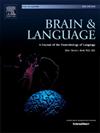The neural mechanisms underlying semantic unification and semanteme integration
IF 2.3
2区 心理学
Q1 AUDIOLOGY & SPEECH-LANGUAGE PATHOLOGY
引用次数: 0
Abstract
The basic composition processing of human language (at least) contains semantic unification and semanteme integration. However, previous researchers only focused on the neural mechanism underlying semantic unification. In the current study, participants were asked to complete both the semantic unification and semanteme integration tasks while undergoing functional magnetic resonance imaging (fMRI) scanning. In each task, the violated and congruent conditions were constructed. The regional activation analyses showed that the violation effect (violated > congruent) elicited more activation in the right anterior temporal lobe (RATL) in the semantic unification task and more widespread activation in the semanteme integration task. Moreover, the results of psychophysiological interaction (PPI) analyses showed that the violation effect elicited significant connectivity such as between RATL and bilateral angular gyrus (AG) only in the semanteme integration task. Altogether, these results suggested that semanteme integration elicited more activation and functional connectivity compared with semantic unification.
语义统一和语义整合的神经机制
人类语言(至少)的基本构成过程包括语义统一和语义整合。然而,以往的研究只关注语义统一背后的神经机制。在本研究中,参与者被要求在进行功能磁共振成像(fMRI)扫描的同时完成语义统一和语义整合任务。在每个任务中,构造违和条件和一致条件。区域激活分析表明,违逆效应(violation >;在语义统一任务和语义整合任务中,右颞叶前部(RATL)的激活更为广泛。此外,心理生理相互作用(PPI)分析结果表明,违反效应仅在语义整合任务中诱发了RATL与双侧角回(AG)之间的显著连通性。综上所述,这些结果表明,与语义统一相比,语义整合引发了更多的激活和功能连接。
本文章由计算机程序翻译,如有差异,请以英文原文为准。
求助全文
约1分钟内获得全文
求助全文
来源期刊

Brain and Language
医学-神经科学
CiteScore
4.50
自引率
8.00%
发文量
82
审稿时长
20.5 weeks
期刊介绍:
An interdisciplinary journal, Brain and Language publishes articles that elucidate the complex relationships among language, brain, and behavior. The journal covers the large variety of modern techniques in cognitive neuroscience, including functional and structural brain imaging, electrophysiology, cellular and molecular neurobiology, genetics, lesion-based approaches, and computational modeling. All articles must relate to human language and be relevant to the understanding of its neurobiological and neurocognitive bases. Published articles in the journal are expected to have significant theoretical novelty and/or practical implications, and use perspectives and methods from psychology, linguistics, and neuroscience along with brain data and brain measures.
 求助内容:
求助内容: 应助结果提醒方式:
应助结果提醒方式:


